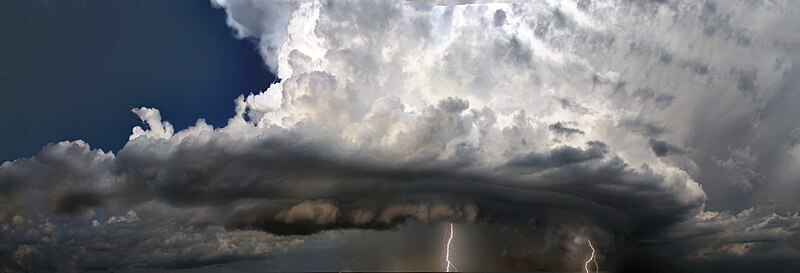
The flashing tentacles of light in lightning are a visual manifestation of an electrostatic discharge between two electrically charged regions in storm clouds, or between storm clouds and the Earth's surface.
Storm clouds are like giant electrical capacitors in the atmosphere. The upper region is positively charged. The lower region is negatively charged. The cause of these electric potential differences is inconclusive in the scientific community.
The flash of light we see occurs at the moment oppositely charged regions equalize. Lightning can occur from a cloud to itself; from cloud to cloud; or between a cloud and the ground.
Mythology
The awe-inspiring power, and the fear-inducing and potentially destructive nature of lightning, beget deeply held cultural mythologies throughout the ages.
In ancient and modern cultures, a lightning bolt is often considered a weapon of a sky god to be deployed as an act of retribution.
Prominent cultural mythologies:
 |
Zeus' head and thunderbolt
coin from Epirus, 234 BC |
- The thunderbolt was a weapon given to Zeus in Greek mythology by the Cyclops (and Jupiter in Roman mythology). Lightning appeared on Greek and Roman coins;
- In the Hebrew Bible, arrows are represented as lightning in Habakuk 3:11 and as divine punishment in Deuteronomy 32:42, Psalms 64:7, and Job 6:4;
- In Hittite mythology, a triple thunderbolt was one symbol of Teshub;
- In Vedic religion, and later Hindu mythology, Indra is the god of lightning armed with a thunderbolt;
- In Celtic mythology, Taranis is the god of thunder;
- Thor is the god of thunder in Germanic mythology;
- Bai-Ülgen creates the thuderbolts in Turkish mythology;
- In Maya mythology, Huracan is sometimes represented as three thunderbolts;
- The Ani Hyuntikwalaski, or thunder beings, are beings that cause lightning fire in a hollow sycamore tree in Cherokee mythology;
- The Thunderbirds, Nimkiig or Binesiiwag in Ojibway mythology, create thunder and lightning that's both benevolent and malevolent to people;
- In Igbo mythology, the thunderbolt is the weapon of Amadioha; and
- In the Yorùbá religion, the thunderbolt is the weapon of Shango.

"Why the Egyptian, Arabic, Abyssinian, Choctaw? Well, what tongue does the wind talk? What nationality is a storm? What country do rains come from? What color is lightning? Where does thunder go when it dies?"
― Ray Bradbury, Something Wicked This Way Comes
Temperature, Frequency, Sound and Light
The maximum temperature in lightening (52,540 °F) is about five times hotter than the surface of the sun (10,340 °F).
There are about 1.4 billion lightning flashes per year in the Earth's atmosphere occurring approximately 40–50 times a second.
Thunder is the sound of the shock waves emanating from the intense electrical discharge.
Lightning emits white light, but appears as different colors depending on local atmospheric conditions.
"It is in the darkness of their eyes that men get lost"
― Black Elk(1863 – 1950), from Black Elk Speaks
REFERENCES
.jpg)











